There’s growing recognition of the role of food in health, on both the supply side of grocers, food growers and consumer marketers; and, among consumers who are, increasingly, shopping for food with health on their minds.
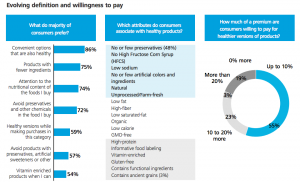 8 in 10 consumers in the U.S. enter a grocery store thinking about the health attributes of what they’re about to choose from the aisles that are stocked with more gluten-free, GMO-labelled, and organic products, according to the 2015 Deloitte Pantry Study. Our physicians have begun to “prescribe” food, especially as the collective BMI of Americans has reached medically catastrophic levels. See this forecast from a recent United Health Foundation report expecting that as Boomers grow into old age, they’ll be sicker than the Boomers of ten and twenty years ago due to dramatically larger waistlines, high sodium consumption and blood pressure issues, and epidemically high metabolic disorder prevalence rates among older Americans. Consumers are willing to pay for healthier food: 55% say they’re willing to pay a premium up to 10% over the usual cost, and 23% would be willing to pay over 10-20% more for the healthier version of a food product.
8 in 10 consumers in the U.S. enter a grocery store thinking about the health attributes of what they’re about to choose from the aisles that are stocked with more gluten-free, GMO-labelled, and organic products, according to the 2015 Deloitte Pantry Study. Our physicians have begun to “prescribe” food, especially as the collective BMI of Americans has reached medically catastrophic levels. See this forecast from a recent United Health Foundation report expecting that as Boomers grow into old age, they’ll be sicker than the Boomers of ten and twenty years ago due to dramatically larger waistlines, high sodium consumption and blood pressure issues, and epidemically high metabolic disorder prevalence rates among older Americans. Consumers are willing to pay for healthier food: 55% say they’re willing to pay a premium up to 10% over the usual cost, and 23% would be willing to pay over 10-20% more for the healthier version of a food product.
That’s the demand side, and retail food purveyors are paying attention to this growing movement of consumers seeing food-as-medicine, from the largest national and global food chains to hyper-local storefronts serving neighborhoods of foodies and healthy eaters.
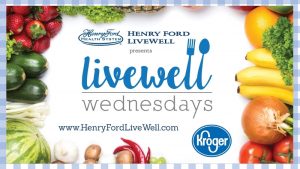
A picture-perfect example of healthcare reaching across the ecosystem toward health via food is the venture announced this week by Kroger and Henry Ford Health System in Detroit. The press release for the project makes it clear in its title: “Henry Ford Health System and Kroger Forge New Partnerhip to Help Families Eat Healthier.” On Livewell Wednesdays, which kicked off on June 1st at all 126 Kroger stores in Michigan, Henry Ford nutritionists provide a recipe with a shopping list for all the ingredients, as well as an online link to cooking demonstrations. Nutritionists come live to four Kroger stores to discuss food and health with shoppers. “We view wellness as a lifelong journey – a daily commitment to making the right choices when it comes to things like healthy eating. Having a presence inside every Kroger in the state of Michigan is a great way to reach the people in the communities we serve,” said Kimberlydawn Wisdom, MD, Senior Vice President of Community Health & Equity and Chief Wellness and Diversity Officer at Henry Ford Health System, in the press release.
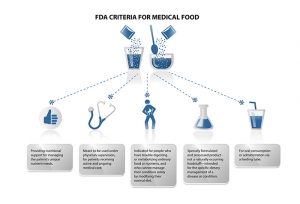 With the growth of food manufacturers growing their “medical food” portfolios, the FDA published guidance on the topic in May in the form of frequently asked questions. Medical foods are defined in the Orphan Drug Act as, “a food which is formulated to be consumed or administered enterally under the supervision of a physician and which is intended for the specific dietary management of a disease or condition for which distinctive nutritional requirements, based on recognized scientific principles, are established by medical evaluation.” These do not require a prescription like prescription drug products, but they are meant to be administered under the supervision of a physician. This means, according to the FAQ, for the dietary management of a patient receiving active and ongoing medical supervision in a health care facility or as an outpatient by a physician who has determined that the medical food is necessary to the patients’ overall medical care.
With the growth of food manufacturers growing their “medical food” portfolios, the FDA published guidance on the topic in May in the form of frequently asked questions. Medical foods are defined in the Orphan Drug Act as, “a food which is formulated to be consumed or administered enterally under the supervision of a physician and which is intended for the specific dietary management of a disease or condition for which distinctive nutritional requirements, based on recognized scientific principles, are established by medical evaluation.” These do not require a prescription like prescription drug products, but they are meant to be administered under the supervision of a physician. This means, according to the FAQ, for the dietary management of a patient receiving active and ongoing medical supervision in a health care facility or as an outpatient by a physician who has determined that the medical food is necessary to the patients’ overall medical care.
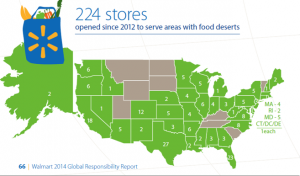 The third data point this week at the food/health nexus is Walmart, the nation’s largest grocery chain, which is opening a new “supercenter” in southern Cook County, Illinois – a food desert as determined by the U.S. Department of Agriculture. Food deserts are defined by the USDA as, “low-income census tracts where a significant number or share of residents is more than one mile … from the nearest supermarket.” In what is touted as the single largest retail development in the history of the Richton Park neighborhood, the store will feature fresh meats, produce, dairy, and other fresh foods. The store will also bolster the local economy with 340 jobs. This store opening comes five months after the company’s closure of 154 U.S. stores (Walmart press release here) which left several areas with food deserts, according to the Associated Press (those communities were cited by AP as Fairfield, AL; Coal Hill, AR; and, Wichita, KS).
The third data point this week at the food/health nexus is Walmart, the nation’s largest grocery chain, which is opening a new “supercenter” in southern Cook County, Illinois – a food desert as determined by the U.S. Department of Agriculture. Food deserts are defined by the USDA as, “low-income census tracts where a significant number or share of residents is more than one mile … from the nearest supermarket.” In what is touted as the single largest retail development in the history of the Richton Park neighborhood, the store will feature fresh meats, produce, dairy, and other fresh foods. The store will also bolster the local economy with 340 jobs. This store opening comes five months after the company’s closure of 154 U.S. stores (Walmart press release here) which left several areas with food deserts, according to the Associated Press (those communities were cited by AP as Fairfield, AL; Coal Hill, AR; and, Wichita, KS).
Health Populi’s Hot Points: 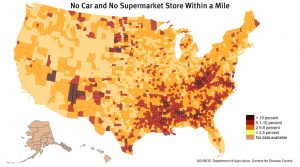 The food desert problem cannot be underplayed when it comes to food as a social determinant of health. Note on the first map the places with the dark brown color that tend darker brown are in the southern US. states. A similar trend is echoed in the second map, this one representing the poor state of seniors’ health (from United Healthcare Foundation’s latest 2016 America’s Health Rankings study).
The food desert problem cannot be underplayed when it comes to food as a social determinant of health. Note on the first map the places with the dark brown color that tend darker brown are in the southern US. states. A similar trend is echoed in the second map, this one representing the poor state of seniors’ health (from United Healthcare Foundation’s latest 2016 America’s Health Rankings study).
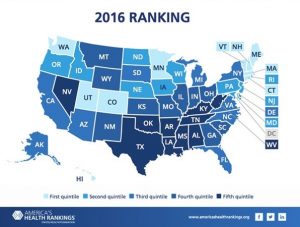 Kroger’s and Walmart’s efforts to bolster healthy eating and nutrition knowledge among store shoppers are important steps to helping everyday people integrate good food into their daily lives. They also represent the fact that health is bolstered where people live, work, play, and shop. Retail channels are key touchpoints for driving health in communities.
Kroger’s and Walmart’s efforts to bolster healthy eating and nutrition knowledge among store shoppers are important steps to helping everyday people integrate good food into their daily lives. They also represent the fact that health is bolstered where people live, work, play, and shop. Retail channels are key touchpoints for driving health in communities.
There’s an important policy context around the local issue of food deserts, and it’s the larger food system and policy framework that influences what ends up on grocery store shelves. A publication this week from iPES, the International Panel of Experts on Sustainable Food Systems, speaks to this crucial context. From Uniformity to Diversity: A paradigm shift from industrial agriculture to diversified agroecological systems connects the dots between sustainable food systems from the ground (those sustainable agroecological systems) to human health and healthy national economies. “The prevalence of energy-rich crops and foodstuffs continues to be a major factor in the explosion of overweight, obesity, and the associated health impacts,” the paper asserts, leading to the biggest increases in mortality rates over recent years in low and middle income countries.
That food system dynamic continues to drive the health disparities we see in these maps in areas where Americans live under lower socio-economic status. While change is happening, the paper points out, political incentives must shift for the alternative growing formats to move beyond the margins — that is, beyond wealthier communities.
“Concentrations of a range of antioxidants such as polyphenols have been found to be substantially higher in organic crops…many of these have been linked to a reduced risk of chronic diseases,” the report recognizes. While the advent of medical foods, recognized by the FDA’s new guidance, is laudable, healthifying the food supply that reaches people in mainstream grocery stores will help to stem chronic disease where it is most prevalent.


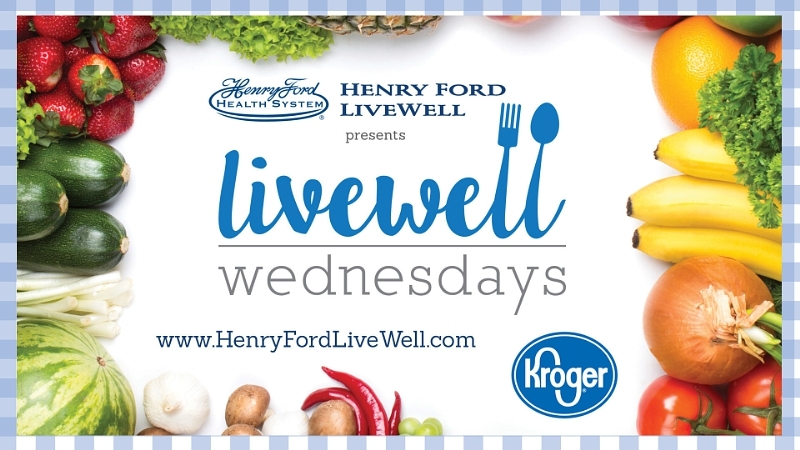


 Interviewed live on BNN Bloomberg (Canada) on the market for GLP-1 drugs for weight loss and their impact on both the health care system and consumer goods and services -- notably, food, nutrition, retail health, gyms, and other sectors.
Interviewed live on BNN Bloomberg (Canada) on the market for GLP-1 drugs for weight loss and their impact on both the health care system and consumer goods and services -- notably, food, nutrition, retail health, gyms, and other sectors. Thank you, Feedspot, for
Thank you, Feedspot, for  As you may know, I have been splitting work- and living-time between the U.S. and the E.U., most recently living in and working from Brussels. In the month of September 2024, I'll be splitting time between London and other parts of the U.K., and Italy where I'll be working with clients on consumer health, self-care and home care focused on food-as-medicine, digital health, business and scenario planning for the future...
As you may know, I have been splitting work- and living-time between the U.S. and the E.U., most recently living in and working from Brussels. In the month of September 2024, I'll be splitting time between London and other parts of the U.K., and Italy where I'll be working with clients on consumer health, self-care and home care focused on food-as-medicine, digital health, business and scenario planning for the future...